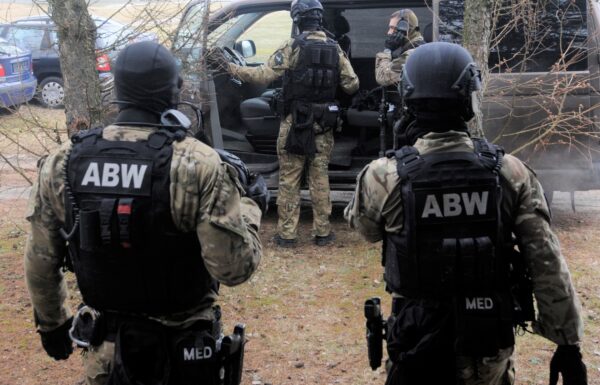A few words of introduction
Over the past few years, and especially in the last three months, the term “blackout” has become a regular feature in media headlines. This is entirely understandable given the nature of the phenomenon and its recent “appearances” across Europe. But what exactly is a blackout? Typing the term into a search engine yields the following definition:
“A blackout is a sudden and widespread failure of the power grid that results in a prolonged power outage over a large area, such as an entire city or region. Unlike short technical interruptions, a blackout can last for many hours, days, or even weeks.”
At MILMAG, we don’t specialize in energy, but we do specialize in security, which is why the topic has caught our attention. As journalists aspiring to be reliable and credible, we value expert-driven content created by people who genuinely understand the subject. And since I recently met an energy expert who works alongside other specialists.
Guests of the discussion

The following experts joined me (TJ) for the discussion:
- Maciej Zaniewicz (MZ) – Senior Analyst in the European Program at Forum Energii. He specializes in energy security and the Ukrainian energy sector.
- Jędrzej Wójcik (JW) – Coordinator of the Power Sector Program at Forum Energii. He is responsible for topics related to the energy transition, power system modeling, and the development of sectoral strategies.
What were the causes of the blackout in Spain?
(TJ) Maybe let’s get straight to the core of this conversation, the blackout that recently occurred in Spain. Initially, there was no information available online about what had actually happened. Later, various speculations emerged, with some blaming renewable energy sources and others suggesting sabotage by Russia. What are the actual causes of what took place there?
(JW) As of the day we’re having this conversation, precisely one month has passed since the blackout that occurred on April 28, 2025. Within just a few hours of the incident, numerous speculations began circulating about its possible causes. Today, we know that many of those reports were disinformation. We can say with complete confidence that it was not an act of sabotage. According to the Spanish authorities and the transmission system operator (REE – Red Eléctrica de España), there was no cyberattack either. We now have a very detailed understanding of the sequence of events. However, identifying a specific technology, device, or entity that might have triggered the incident would be premature at this stage. Analytical and investigative work is still ongoing, and its outcome will be crucial for drawing reliable conclusions.
Challenges in Identifying the Origin
(TJ) Given the current level of technological development and monitoring in the energy sector, why is the cause of the issue still unknown? What makes it so difficult to pinpoint?
(JW) In situations like this, time is the key factor. The Spanish transmission system operator, Red Eléctrica de España, in cooperation with ENTSO-E (the European Network of Transmission System Operators for Electricity), has launched a detailed analysis of the incident. A team of experts has been assembled, including specialists from Poland. Their task is to examine the data recorded on the day of the failure — with a resolution down to individual seconds — from various points across the grid, to reconstruct the sequence of events as accurately as possible and understand what really happened. This process can be compared to air crash investigations, where an independent commission is formed to analyze every detail, and final conclusions often take many months, sometimes even years, to establish. In the case of this blackout, based on past incidents of this kind, I wouldn’t expect final results to be available earlier than in about six months, and possibly even later.
(MZ) All the commentary that appeared immediately after the blackout, blaming renewable energy sources, the grid operator, or other factors, should, for now, be considered speculative or even disinformation. What we know for sure is that a portion of the generation suddenly dropped out of the system. However, the direct causes remain unknown.
(JW) Pointing fingers too early — without access to complete technical data, without a thorough analysis of the sequence of events, and without understanding the actual cause-and-effect chain — risks drawing the wrong conclusions. And that, in turn, can lead to poor decision-making and misguided future recommendations. In such cases, patience is essential, and findings should be based on hard data, not speculation.

Potential Blackout in Poland
(TJ) Although a lot is already known, the actual cause has still not been identified. That somewhat undermines one of the following questions I had prepared: could a similar situation happen in Poland?
(MZ) A situation like this can happen anywhere, in any power system. In Spain, there was a sudden loss of 2.2 GW (gigawatts) of generation capacity. That disrupted the balance between supply and demand, which must be maintained every second, leading to cascading shutdowns of subsequent power sources. Events like this can and do happen in other countries as well.
Poland faced a similar threat in 2021, when a short circuit occurred at the Rogowiec substation. It nearly led to a national blackout. At that moment, 3.6 GW of power from the Bełchatów power plant dropped out of the system, even more than what happened in Spain. However, a blackout was avoided because the system operator responded appropriately, reserves were available, and the situation was stabilized within 20 minutes.
It’s also worthwhile to address the widespread speculation that renewable energy sources were to blame for the Spanish blackout. Yes, renewable sources did drop out of the system in that case, but in Poland’s near-blackout event, the affected plant was coal-fired using lignite. In Texas, a major blackout occurred some time ago that was also caused by coal-fired generation. So we can’t simply conclude that the more renewables in a system, the more vulnerable it becomes to such failures. It’s not the share of renewables alone that determines system stability.

Analysis of the Spanish Blackout
(TJ) Let’s move on, then, to the analysis mentioned earlier — could you walk us through, minute by minute or even second by second, how this blackout unfolded? And based on that timeline, are we in a position to implement safeguards? Perhaps we can even develop tools that help us react faster and mitigate the effects of a future blackout, or even prevent such situations altogether. However, I assume that as long as the root cause remains unknown, prevention is still out of reach.
(JW) Let’s take a look at the sequence of events that day, using official information provided by the Spanish transmission system operator and the Minister of Energy. Around 30 minutes before the blackout, two oscillation incidents were recorded in the European power grid — the first at 12:03, and the second at 12:19. The blackout itself occurred at 12:32. At this stage — as both the grid operator and government officials have emphasized — any causal link between these oscillations and the failure remains unclear. That means that while some disturbances were observed beforehand, we cannot definitively say whether they played a role in triggering the blackout. That’s why experts are being very cautious in drawing conclusions.
(TJ) Let me just briefly interrupt — could you elaborate on the term “oscillations”, so it’s clear what exactly we’re talking about?
(JW) Of course. The European power grid is a highly complex, interconnected system — countries in continental Europe are physically synchronized, meaning that all power plants, from Portugal to Estonia and even parts of Ukraine, operate in the same rhythm. In practice, this means that generators across all these countries spin at the same speed — 50 rotations per second, or 50 Hz. This rotation speed defines the grid frequency — a key parameter that indicates the stability of the entire electrical system. The oscillations we’re referring to are small but measurable fluctuations in that frequency — occurring sometimes over just a few seconds or even microseconds — in different parts of the grid. That means the frequency in certain areas briefly increases or decreases before the system attempts to stabilize itself again. While these changes may seem minor, they can signal more serious dynamic problems in the system’s operation, especially when there is a high share of variable sources, such as renewables, or limited regulatory reserves available. It’s a very subtle phenomenon — and at the same time, a good example of how intricate and finely tuned the European power grid really is.

(TJ) I see. So the disturbance in frequency likely caused wave reinforcement and cancellation, and that could have brought the whole system down, is that right?
(JW) Exactly. The operator did take stabilizing actions, but we still don’t know if or how the earlier oscillations directly contributed to the blackout. What we do know with more certainty now is that during the two incidents immediately preceding the failure, the Spanish system lost approximately 2.2 GW of generation, and that occurred within just a matter of seconds. At that moment, the total electricity demand in Spain was around 25 GW, so the loss was significant, accounting for nearly 9% of the instantaneous demand.
That loss triggered a cascading generation failure — essentially a chain reaction caused by system destabilization. As a result, the voltage increased while the frequency dropped, which activated the automated safety mechanisms. In accordance with procedures, some generating units were automatically disconnected from the grid to prevent physical damage to power plants.
In the following seconds, the Iberian system (covering Spain and Portugal) became separated from the rest of continental Europe. The interconnector with France was shut off from the Spanish side, also for safety reasons, which prevented external system support from being delivered, further deepening the instability.
The next step was the automatic reduction of power demand — known as load shedding — a controlled shutdown of selected consumers to bring demand in line with available generation, which was no longer sufficient to meet overall system needs. At the same time, a pumped-storage power plant that was in pumping mode — consuming rather than generating electricity — was instantly taken offline, which was unavoidable given the critical power imbalance.
Ultimately, according to the operator’s data, the system frequency dropped to 48 Hz, whereas the nominal frequency should be 50 Hz; even slight deviations are usually immediately corrected by automatic controls. At exactly 12:33:24, the system fully collapsed — generation dropped to zero, and with it, power consumption ceased. The entire power system of the Iberian Peninsula shut down, and from that moment, a prolonged recovery process began.
(MZ) Just before the blackout, Spain’s nuclear power plants were still operating. These also had to shut down for safety reasons once the frequency deviation became too large. A similar mechanism occurred in Ukraine in November 2022, when a nationwide blackout took place. Even though half of Ukraine’s electricity generation comes from nuclear reactors — and none of them were directly bombed — the loss of other sources and damage to the grid made it necessary to shut down the nuclear plants, even though they were technically still capable of producing power.
So it’s simply not true that more renewable energy sources automatically mean more outages, or that coal and nuclear automatically guarantee stability. That’s not how it works. The sudden loss of a large coal or nuclear plant can cause similar consequences. Blackout resilience is not an argument for or against nuclear, coal, or renewables — the reality is far more complex.

Renewables as protection against effects of blackout
(TJ) Since we’re already talking about renewable energy sources, what about off-grid power setups? Say someone has solar panels, a heat pump, and other systems at home, essentially trying to be energy-independent. In the case of a single household, could that be a way out? Could solar generation, for instance, be enough to keep a household running? I realize it depends on the size of the “solar farm,” but in general, is it currently realistic in Poland to protect oneself from the effects of a blackout this way?
(MZ) It all depends on what kind of scenario you’re preparing for. If we’re talking about a blackout like the one that occurred in Spain, or, say, attacks on infrastructure like those Ukraine faces during the war, then I would strongly advise against mass adoption of off-grid systems or a “prepper” mindset.
In Spain, the power was out for about 20 hours. In Ukraine, which is constantly being bombed, with energy infrastructure as a primary target, a full-scale, nationwide blackout, where virtually the entire country lost power, happened only once during over three years of war. Yes, there are also situations involving load shedding, where, for example, a city district experiences power outages for a few hours. However, those outages usually last just a few hours a day, and they’re typically announced in advance by the operator.
To prepare for that kind of situation, the average household only needs basic items: a flashlight, a small supply of water and batteries, maybe a power bank to charge a phone, because a blackout doesn’t necessarily mean you’ll lose connectivity, as mobile base stations (BTS) typically have backup power systems. Going entirely off-grid or investing in a blackout box is disproportionate to the actual risk.

The situation is entirely different, however, if you live in a single-family home in the mountains or in a region like Podlasie, where the power grid is less dense and a regular snowstorm or strong wind can take down a power line. I have friends who deal with power outages lasting several days almost every winter. For them, it’s normal to install solar panels, ideally combined with a battery storage system and an off-grid setup, or at the very least, to invest in a generator that can cover their basic needs during such periods.
(JW) While traditional off-grid systems are indeed very costly and rarely used in practice, there is a growing case for hybrid solutions, especially for single-family homes. I’m mainly referring to battery storage systems paired with rooftop solar installations. These setups not only provide basic power in the event of a grid failure but also enhance the overall economics of the investment, allowing for greater self-consumption and more efficient use of locally generated electricity. What’s more, such batteries can actively support the local grid by reducing peak demand or providing short-term power regulation. That’s why the direction in which households are equipped not just with PV panels, but also with local battery storage — and possibly electric vehicles with V2H (vehicle-to-home) capability — is a step not only toward greater energy independence, but also toward increased resilience of the entire power system.
(MZ) And with that, we naturally transition into a broader discussion about strengthening both system and societal resilience through the decentralization of the power grid. That’s a process already unfolding before our eyes. Poles are installing rooftop solar panels on a massive scale, increasingly combining them with energy storage systems and heat pumps. However, their motivation isn’t necessarily blackout preparedness — it’s the favorable economic return.
There’s no need to panic, just because power outages can happen. Blackouts are a bit like plane crashes — they’re extremely rare. Still, when they do occur, they’re dramatic and highly emotional events. That’s precisely why so much effort is invested in learning from each such incident and preventing future failures. Jędrzej’s earlier comparison to international commissions that investigate plane crashes is spot-on. It’s a painstaking process, but one that ultimately produces a precise report and concrete recommendations for the future.
(JW) Exactly — and we do learn from them, which is why air travel remains the safest mode of transport there is.
Problematic System Restart
(TJ) You almost got yourselves in trouble with the preppers. But let’s get back to Spain for a moment, because there’s something I’ve been wondering about. I’m trying to put myself in the shoes of someone who knows as much about electricity as “it comes out of the socket.” If the issue is that different elements of the grid fall out of sync, which causes the whole system to collapse, then, in simple terms, it might seem like you could just restart everything at once. I’m guessing it’s not that simple, and I hope you can explain why.
(JW) When a blackout occurs, restarting the entire power system is a highly complex process — one that is far more intricate than simply flipping a light switch or starting a car engine. The power grid is a sophisticated structure in which every generating unit — whether it’s a conventional, gas, coal, or nuclear plant — actually needs electricity to start operating. Power must be supplied to run coal conveyors, air blowers, cooling pumps, automation systems, control equipment, lighting, and all auxiliary infrastructure. Without an external power source, a power plant simply can’t start up.
That’s why, after a blackout, we use a procedure known as a black start, which involves using energy sources that can start up independently. These are typically hydroelectric power plants, capable of starting operation without external power. They are connected via specially designated, physically separated lines to selected conventional power plants, using the hydro power to energize the auxiliary systems of those units, gradually rebuilding the system from there. Alternatively, local backup generators — large-scale diesel or gas units installed on-site — may be used.
It’s also worth noting that nuclear power plants, by design, do not participate in black start procedures. If they shut down suddenly, for example, due to a blackout, they experience what’s called xenon poisoning of the reactor core. This means the reactor can’t be restarted until several, sometimes dozens of hours later, only once the concentration of xenon-135 drops to a level that allows stable operation.
In Spain’s case, based on the available operational data, hydroelectric plants played a crucial role in rebuilding the system, alongside conventional generators and electricity imports from France. Once the first self-starting units were back online, they began forming so-called power islands — local sections of the grid with an active generation source and gradually reconnected consumers and other power plants. These islands grew, interconnected, and supported each other until the entire Iberian system was resynchronized and re-integrated into the pan-European power grid.
(TJ) So, from a strategic standpoint, it’s not so much coal or nuclear plants we should be worried about in this context, but rather the few that don’t require external power to start up — like hydro plants, right?
(JW) Exactly. In Poland, in the event of such a failure, it would be hydroelectric plants that help restart and rebuild the national power system. However, some combined heat and power (CHP) plants are equipped for this purpose. If I remember correctly, the Żerań CHP plant in Warsaw, for instance, has backup engines that allow the facility — in this case, a gas plant — to be started independently.
(MZ) That also helps explain why hydro and coal plants, as well as power substations, have been, and continue to be, prime targets of Russian airstrikes. By destroying them, it’s one of the simplest ways to cause a blackout or widespread outages, and make it especially difficult for operators to restore the system afterward.


AI in Blackout Prevention
(TJ) I have one more question, not exactly your area of expertise, but I’ll take a chance. There’s a lot of talk right now about artificial intelligence. Could applying AI to analyze incidents, such as recent blackouts, lead to more effective tools for detecting anomalies and preventing outages? Or is this still something that fundamentally requires human input — someone who, with their ability for abstract thinking, can spot warning signs even in seemingly normal data?
(JW) You’re right, it’s not exactly our core field, but from what I know, such mechanisms have already been in use for years. Systems like predictive maintenance, for example, are designed to detect failures or damage before they happen, helping prevent random incidents. That allows you to replace a component in a turbine or power plant before it breaks, enabling scheduled maintenance rather than an unplanned outage, and that definitely contributes to improving energy security.
Regarding the system’s operation, simulations and analyses are conducted daily, often multiple times a day, on both the Polish and European power systems. This is all done to plan the operation of hundreds of power plants, as well as to maintain control over how electricity flows through the complex grid. When it comes to analyzing a specific event like this blackout, however, I’d say we should leave that to the experts in data science and AI.
(MZ) There’s another factor worth mentioning in the context of system planning: the weather. Renewables are often criticized for being uncontrollable and weather-dependent. That’s true, but it’s also true that we can forecast the weather with quite a high degree of accuracy. The system operator isn’t just fumbling blindly in the dark, hoping for favorable conditions from the gods of Helios and Aeolus. They can reasonably predict the weather for a given period and adjust the output of dispatchable units accordingly — such as gas, coal, or hydro — and also make strategic use of battery storage.
You can actually see the results of this planning in a smartphone app called Kompas Energetyczny, released by the Polish grid operator PSE. It shows the so-called green, yellow, and red hours — in simplified terms, periods when electricity demand relative to generation is low, high, or very high. From the operator’s perspective, green hours are ideal for increasing your electricity use — that’s usually when there’s the most renewable energy in the system and the lowest prices. For example, if you can adjust your energy use, it’s better to run your washing machine during green hours rather than yellow ones. Green hours typically occur around midday, when solar production is at its peak.
In short, demand and supply planning is part of everyday operations for system operators around the world.

SMRs in the Context of Blackouts: Yes or No?
(TJ) Still on the subject of system stabilization, there has been a recent surge in discussion about Small Modular Reactors, or SMRs. What’s your view on the role of such units in the context of our conversation, that is, blackouts? Could they be helpful, or would they essentially function the same way as conventional large-scale nuclear reactors?
(JW) As I mentioned earlier, both large and small nuclear reactors have significant limitations when it comes to blackouts. Not only are they unable to participate in the grid recovery process (black start), but they also require a stable operating environment. By their nature, they can only function when the system is already stable and not subject to frequent or dynamic load changes.
Another key issue is the high capital cost. Nuclear power plants are among the most capital-intensive technologies out there. Building such a unit involves a massive investment, which drives the need for a particular mode of operation. From the investor’s and operator’s perspective, the goal is to maximize runtime at full power — ideally for most hours of the year — to ensure the shortest possible payback period. That means nuclear reactors are primarily designed and used for baseload operation, with very limited ability to ramp power up or down.
This lack of flexibility isn’t just economic; it’s also technological. While a reactor can theoretically adjust its output relatively quickly, in practice, this is not a standard feature. Frequent power changes affect core behavior, fuel cycles, and physical phenomena such as xenon poisoning. That’s why nuclear plants generally avoid load-following in their daily operations.
And this creates a serious challenge for the system. Demand profiles are becoming increasingly volatile, changing by the time of day, season, and weather. At night, demand is low. During the day, it increases, with pronounced morning and evening peaks, the most stressful times for the system. At the same time, variable renewable sources, such as solar and wind, are gaining market share. For example, in summer, PV systems produce nothing at 4 a.m., but by noon, they may account for up to 60% of a country’s electricity generation.
Wind power is also variable, depending on local weather conditions, which makes real-time grid balancing even harder. One of the most pressing challenges in today’s power systems is enhancing flexibility. That means developing balancing assets, such as battery storage, gas peaker plants, and, in some cases, fast-ramping coal units, provided they can start quickly and modulate their output effectively.
(MZ) In the UK, there’s a sudden spike in electricity demand during breaks in major football matches or popular TV shows, when everyone turns on their electric kettles, which draw a lot of power. This even has a name: TV pickup. Such sudden surges could destabilize the grid and lead to outages. But the operator can predict them and deploy flexible power reserves to cover the demand spike.
What are those flexible sources? Primarily gas peaker plants and pumped-storage hydro stations, but also battery storage systems that can instantly “enter” the grid. To a degree, coal plants can also help, but in Poland, most of them aren’t flexible enough; they require too much time to ramp up.
So, to answer your question about SMRs, at the end of the day, they’re still nuclear reactors, and they don’t address this flexibility need. In my view, the entire SMR debate is somewhat distorted. Where SMRs make sense is in large, energy-intensive industries, where power demand is stable and can be planned years in advance, with a clear business case to support it. In that case, building an SMR — whose output is predictable and whose costs can be factored into long-term planning — makes a lot of sense.
This technology definitely has its place, but it shouldn’t be seen as a silver bullet for our energy challenges.
(TJ) Given the recent increase in defense spending across Europe, do you think anyone might consider using SMRs to make the defense industry independent from the grid?
(MZ) That conversation is happening. In Ukraine, for example, arms factories — among others — are exempt from load shedding, meaning they’re not subject to planned outages even after Russian strikes on power plants. That’s understandable. These factories also have their backup generators and so on. However, the idea isn’t to make such facilities entirely off-grid — it’s about making them resilient to disruptions and providing them with predictable energy prices.
Across the EU, there’s now a major debate on how to ensure energy costs don’t hurt the competitiveness of the European economy. Turning a factory into a fully self-sufficient off-grid island would, in many cases, bankrupt it long before any foreign aggressor could.
The goal is to improve resilience to crisis situations, but while keeping energy affordable.
Conclusion
(TJ) Understood. For now, I think we’ve more or less covered the topic. That said, if any new information comes to light about what actually happened in Spain, I hope you’ll let us know so we can share the findings with our readers. And hopefully, we’ll also be able to have a more detailed conversation then about whether Poland is better or worse prepared in that regard. But for now — to keep it brief — thank you both very much for the conversation, and I hope we’ll speak again in the future.
(MZ & JW) Thanks. Talk to you soon.































